Research Topics
Plasma-Assisted Combustion and CO2 Conversion
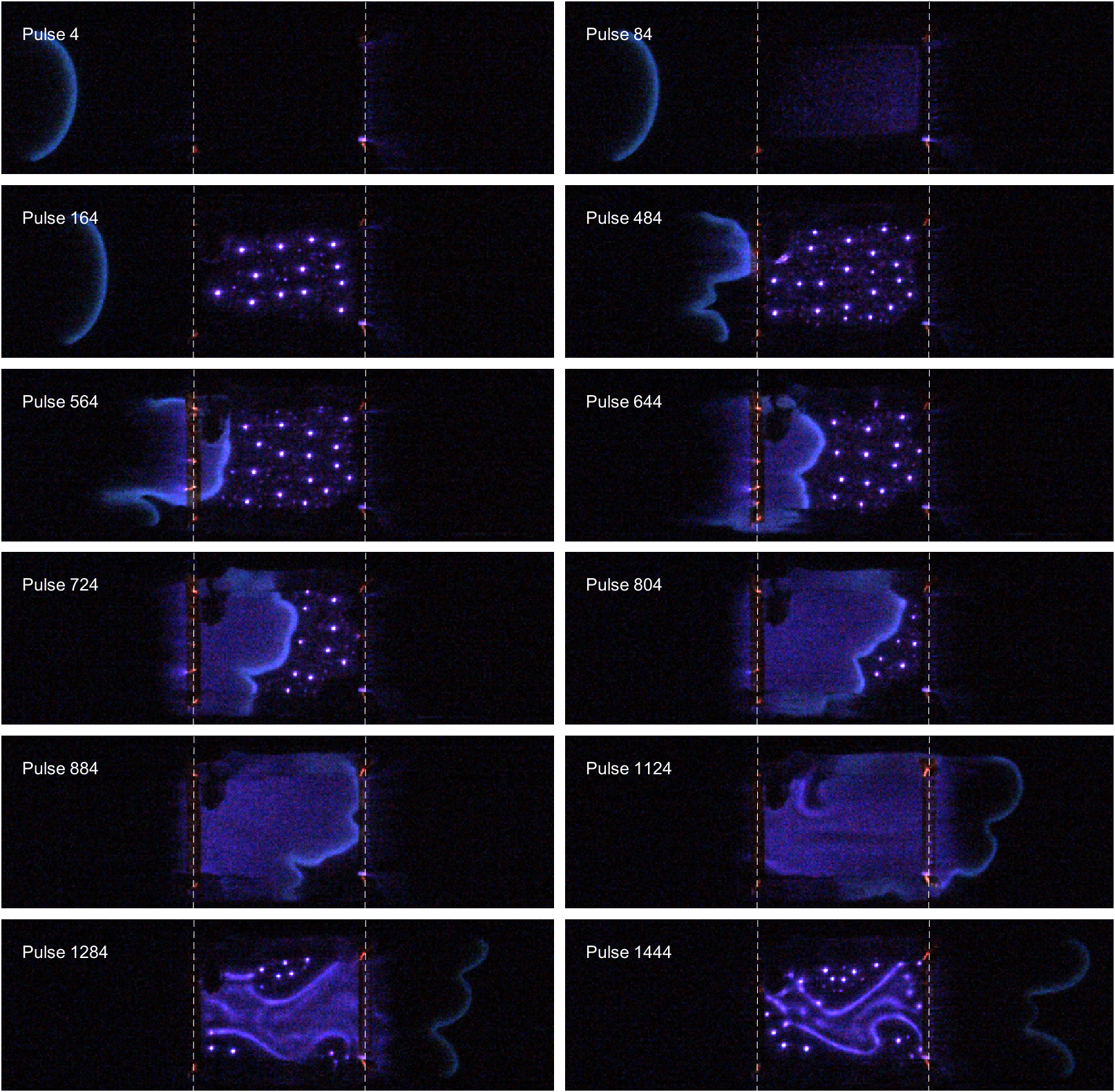
Plasmas in Flames
Nanosecond pulsed discharges are a promising technology to improve the static and dynamic stability of flames. Whereas most works have centered on the impact of the plasma on the flame, fewer studies have focused on the implications of having a strongly inhomogeneous and unsteady environment on the discharge characteristics. In this experimental work we quantify the response of the discharge mode and energy deposition to dynamic combustion environments. The first experimental setup considers a premixed methane/air mesoscale combustor, that allows for 1D laminar flame propagation and provides a simple-to-characterize gaseous background, coupled to nanosecond repetitively pulsed discharges in a dielectric barrier discharge configuration. The study has revealed the strong coupling of the discharge mode and energy deposition with the relative positioning of the flame. The second experiment, in collaboration with RGD Lab and FGC Plasma, considers a burner of more practical interest: a swirl-stabilized combustor of 14kW power under lean conditions and experiencing a 120Hz acoustic instability. The discharge is now generated in a pin-to-ring configuration with the objective of suppressing this instability. In a similar way to the 1D laminar experiment, the discharge evolves over the oscillation cycle of the flame. The results from this work have implications when designing plasma-assisted actuation strategies. Learn more
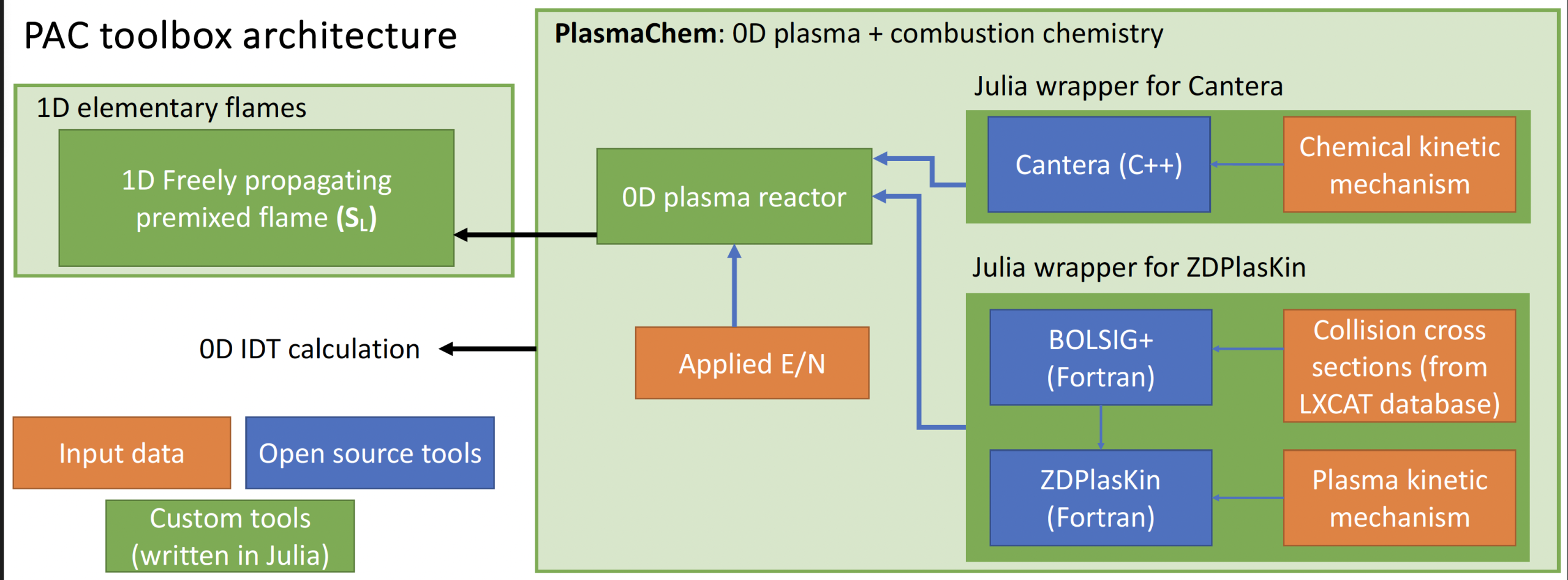
Models of plasma-assisted combustion for reactor design
We are developing computational models to assess the efficiency and authority of nonthermal plasmas to extend ignition limits and provide flame enhancement. Whereas most efforts in the literature focus either on zero-dimensional detailed kinetic models, or on higher dimensional models with a phenomenological description of the plasma that greatly simplifies its kinetic effects, our work focuses on one-dimensional models that can handle arbitrarily complex chemical kinetic schemes, so that transport effects can be captured while retaining all the relevant chemistry. Our numerical simulation tools include zero-dimensional chemical kinetic solvers that concurrently consider electron-induced chemistry, triggered by plasma, and thermally-induced chemistry, representative of typical combustion reactions; as well as one-dimensional models of flame propagation, ignition and inflammation from filamentary discharges. The objective of these models is to enable engineering design of plasma-assisted combustion technologies through numerical simulation. Learn more
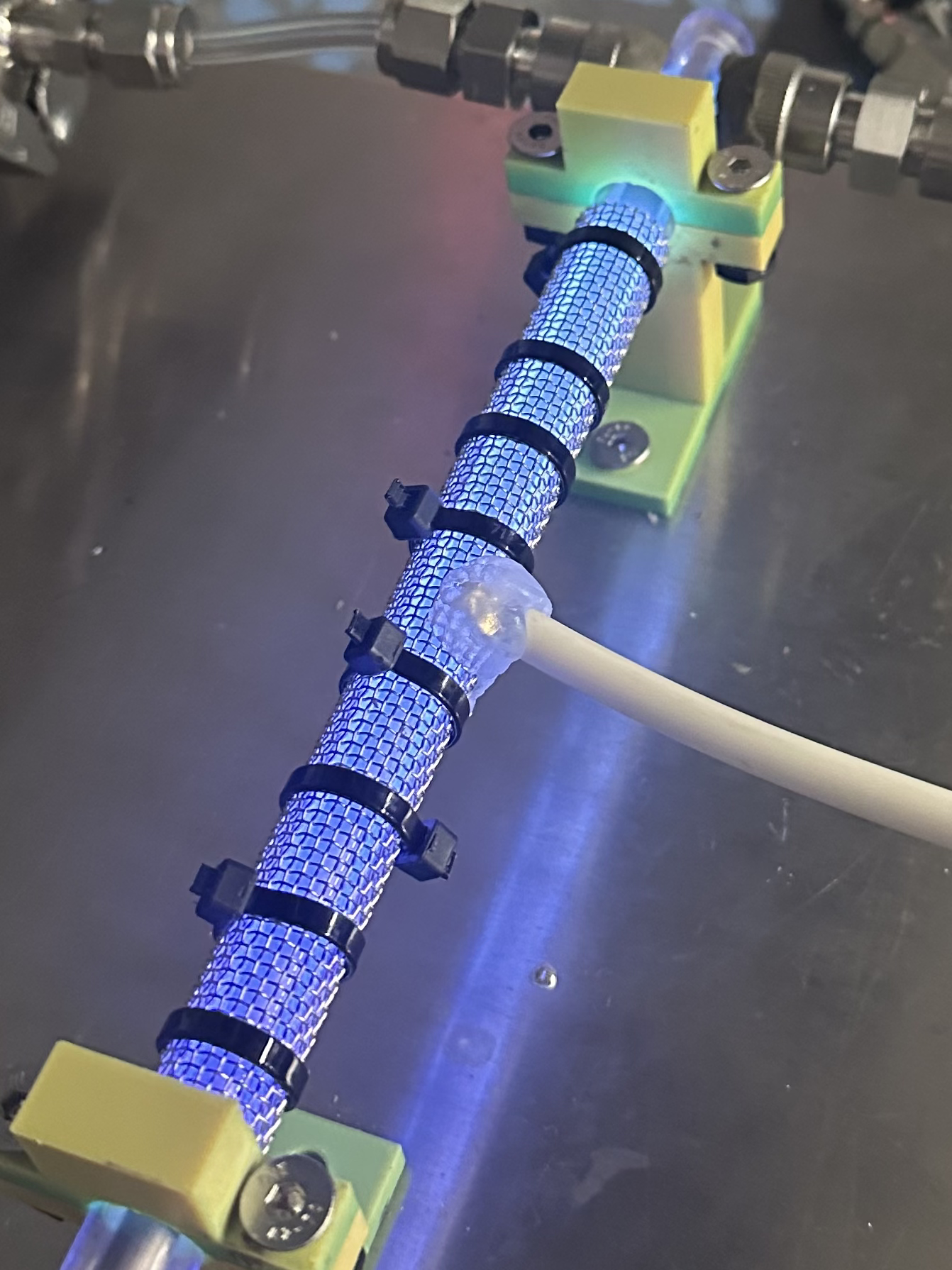
Plasma-assisted CO2 conversion
As society works to reach net-zero, carbon utilization technologies that are both cost- and energy-efficient are essential. An emerging method is plasma-based CO2 conversion, which uses cold electrical discharges to activate and split CO2 via vibrational and electronic excitation. This technology also can be used for in-situ resource utilization (ISRU) on Mars, converting the CO2-rich atmosphere into oxygen for life support, rocket propellant, and other commodities to reduce dependence on Earth resupply. Plasma reactors offer several advantages for Mars missions: they consume only electrical power, function at near-ambient temperature and pressure, are compatible with intermittent power availability, and can enable a wide range of chemical processes. In this effort, we combine kinetic modeling and lab experiments to investigate gas discharge physics, improve energy efficiency, and accelerate technology readiness through strategies such as novel reactor geometries, plasma modifiers and catalysis, and the integration of oxygen-separation membranes. Learn more
Physics-Based Lightning Protection

Aircraft lightning strike risk-mitigation
This project exploits the physics of lightning initiation from aircraft to propose a lightning strike risk-mitigation strategy based on controlling the net electrical charge of the aircraft. The majority of lightning strikes to aircraft are triggered by the aircraft itself, through a bidirectional leader process. Since, under most instances, the positive leader is incepted first, due to lower electric field inception and propagation thresholds, one can envision charging the aircraft to negative charge levels to hinder the process. If done at the correct level, the negative leader might still be avoided, effectively reducing the likelihood of occurrence of the bidirectional discharge. The practical implementation of the strategy would require monitoring the electrical environment, for example, using electric field mills, and actuate accordingly by modifying the net charge of the vehicle, possibly using ion emitting devices, as commanded by an on-board algorithm. In this project we have analyzed the strategy from a theoretical perspective, performed lightning attachment tests in a high voltage laboratory facility, and demonstrated that charge control can be achieved via ion emission, both in the wind tunnel and in flight. Learn more
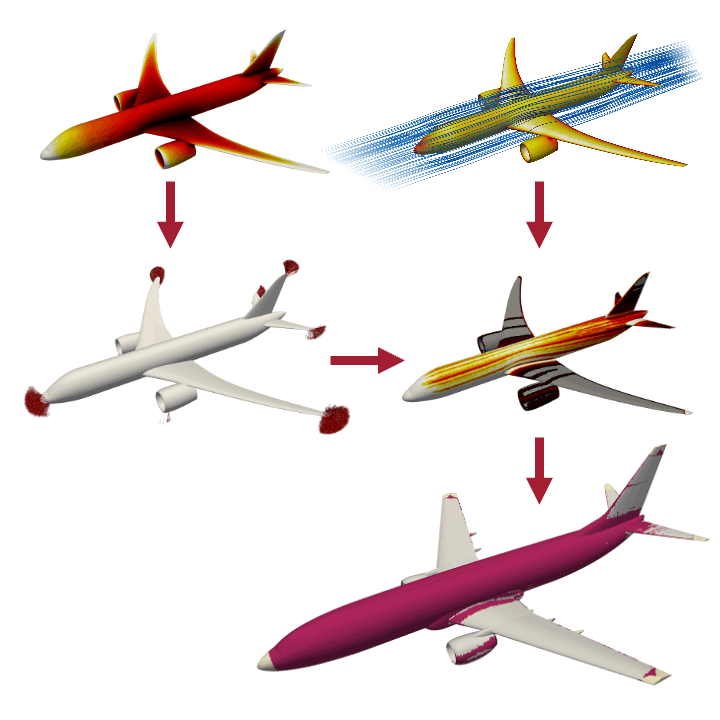
Unconventional aircraft zoning
The protection of aircraft from lightning strikes is an essential component in the aircraft design and certification process. Modern aircraft lightning protection systems are based on decades of experience on conventional aircraft. Protection measures include embedded wire meshes and diverter strips on nonmetallic components, fuel system spark prevention strategies, shielding of wire bundles. While significant progress has been made in aircraft lightning protection, much of what we know about aircraft triggered lightning comes from historical experience and testing. Next generation aircraft designs may include unusual shapes and materials that do not conform to the assumptions which existing modeling and analysis methods are built on. In this project, we are developing computational tools for the prediction of initial and subsequent attachment points on arbitrary aircraft geometries, as well as mapping tools for constructing lightning zoning diagrams from simulation results. The toolkit couples numerical electrostatics, fluid dynamics, and reduced-order lightning initiation and sweeping models, all accelerated using GPU offloading. Learn more
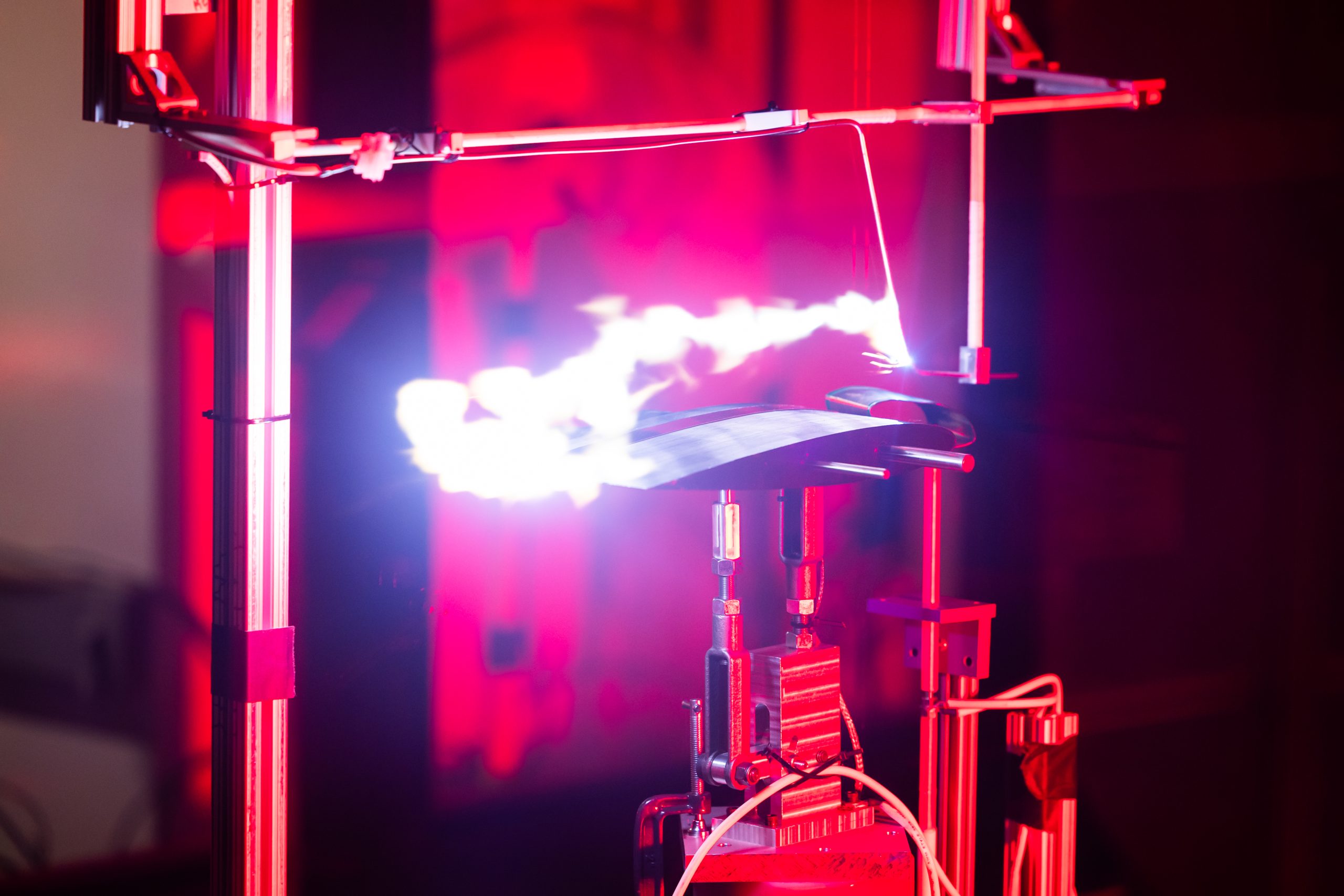
Wind tunnel experiments of long electrical arcs
To investigate the coupling between the fluid flow and electrical arc dynamics, teams from MIT, ONERA, the French-German Research Institute of Saint-Louis, and the Universitat Politécnica de Catalunya apply novel fluid flow diagnostics along with high-speed recordings and electrical measurements to characterize both the electrical arcs and their surrounding flow. Currently, the team is able to generate electrical arcs with voltages of around 3000 Volts and currents of around 6 Amps that last a few hundred milliseconds in wind speeds of up to 22 m/s. Through high-speed recordings and electrical measurements, different properties of the electrical arc can be obtained, such as the internal electrical field and the root attachment and movement behavior. For the fluid flow characterization, Particle Image Velocimetry (PIV) is used to visualize the flow around the electrical arc, helping ascertain the role of boundary layer separation in impeding the arc root’s propagation along the surface of the test sample. More recently, Background Oriented Schlieren (BOS) has also been used to complement the fluid visualization provided by the PIV method. BOS allows the visualization of the fluid density field, even within the arc itself, filling in a gap left by the PIV method. The goal of this campaign is to slowly scale the experiments to one day match real aircraft-lightning interactions so to complement the simulation effort that is underway at the same time. (Photo credit: Jake Belcher). Learn more
Plasma Physics in Aerospace Environments

Experimental studies of streamer coronas
Streamer coronas are widely used as a low temperature plasma source in industrial applications, both established (e.g. ozone generation, air cleaning, electrostatic precipitators) and emerging (e.g. CO2 conversion, ignition, combustion, medicine, water treatment, catalysis). They also appear in nature, at largely different scales, during the formation and propagation of lightning leaders (with implications in aviation and wind power), sprites and blue jets. Despite the wide range of interest, streamer coronas remain a poorly understood phenomenon, in particular, aspects related to the collective nature of streamers or their long-timescale behavior.
Recent work by our group has sought to experimentally measure the electric field inside a positive DC streamer corona, using the recently-developed E-FISH laser diagnostic technique in collaboration with the Princeton Collaborative Research Facility for Low Temperature Plasmas. We measured the electric field at different vertical locations in the streamer corona and over the full time period between two sequential pulses. We found some surprising results regarding the time-dependent behavior of the electric field, which challenge the established theory that the pulsation frequency of the streamers is driven by electric field recovery due to removal of space charge from the inter-electrode gap. Learn more
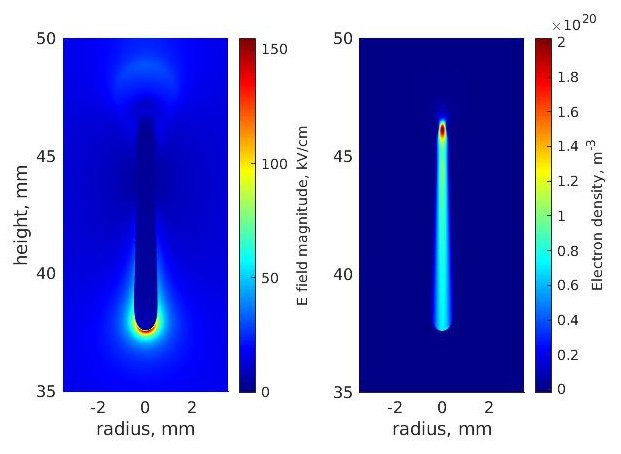
Hierarchical models of streamers
Another aspect of our research into the fundamental physics of streamers is numerical modeling. Our group is developing a hierarchical framework for the modeling of streamer discharges, ranging from 2D axisymmetric fluid models (as shown in the accompanying image), to reduced order models using the 1.5D approximation and description using macroscopic parameters. These reduced order models may serve as building blocks to tackle the more complex problem of a streamer corona in a more computationally-efficient way. Learn more
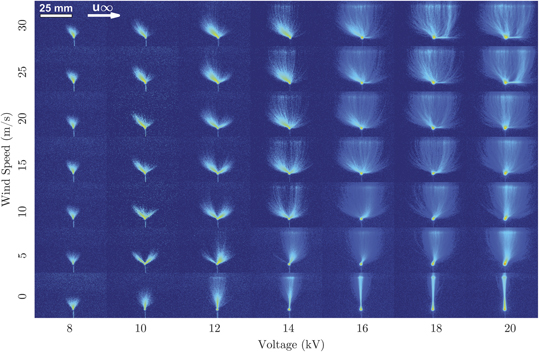
Streamers in airflow
The behavior of streamer discharges in wind is relevant for several problems related to atmospheric electricity, as components of electrostatic discharge and precursors of lightning in wind turbines and aircraft. Experiments of streamers in wind are lacking in the literature, a gap we are working on addressing through wind tunnel campaigns. The objective of this work is both to elucidate the physics of breakdown in wind, as well as explore electrode structures of practical interest (e.g. p-static wicks, wind turbine blade tips, etc.). Learn more